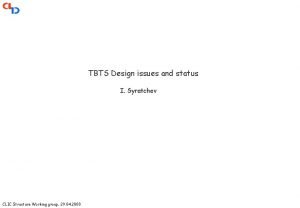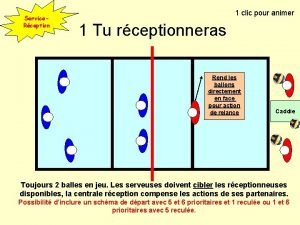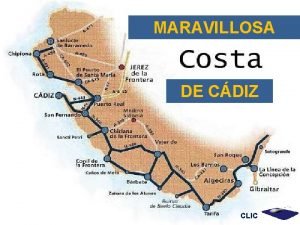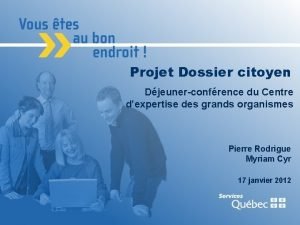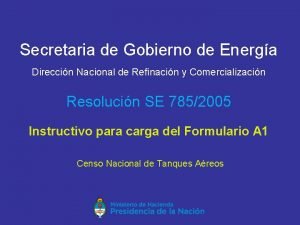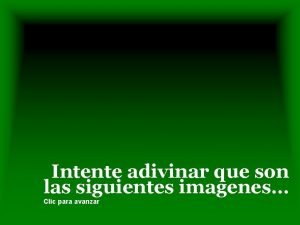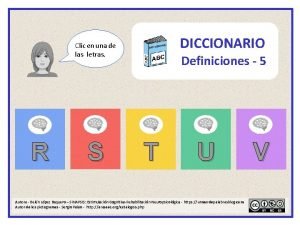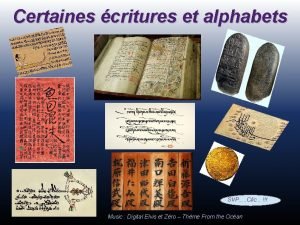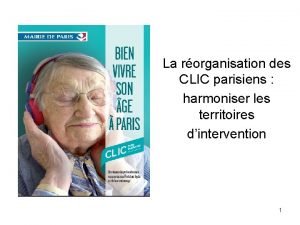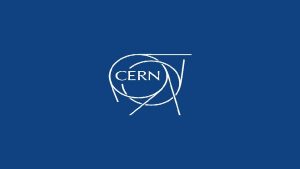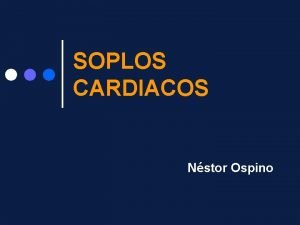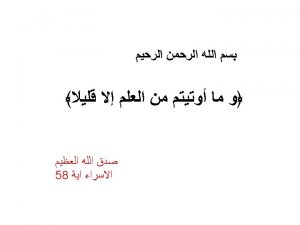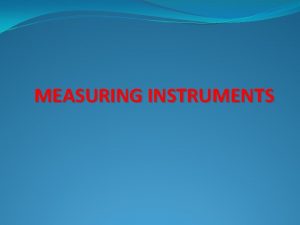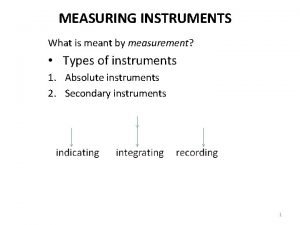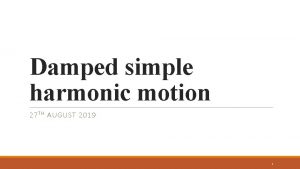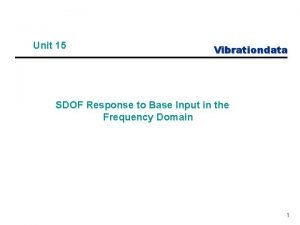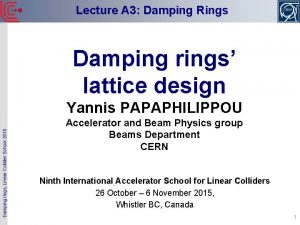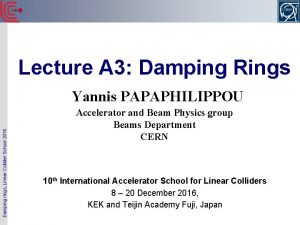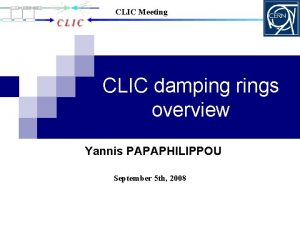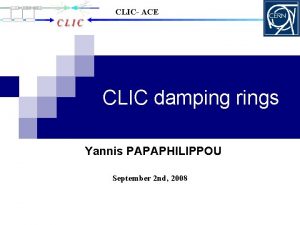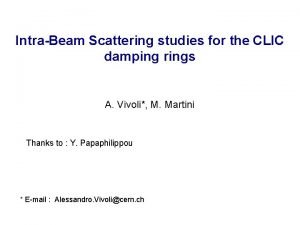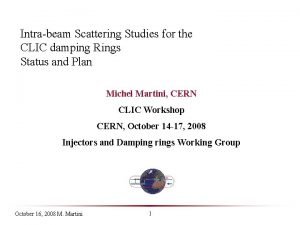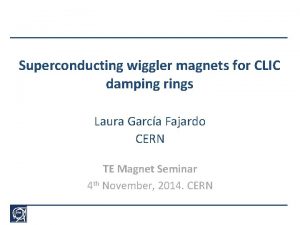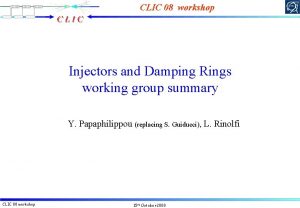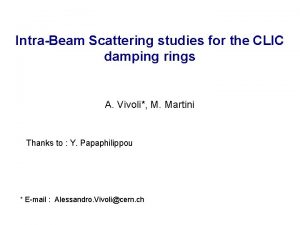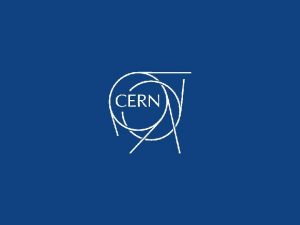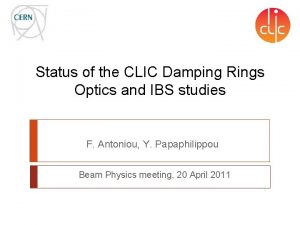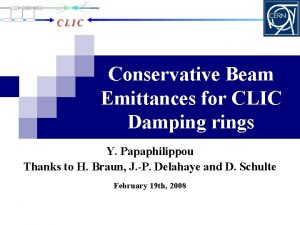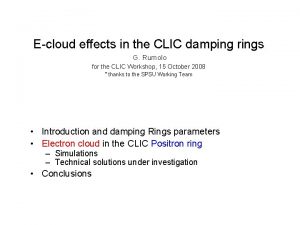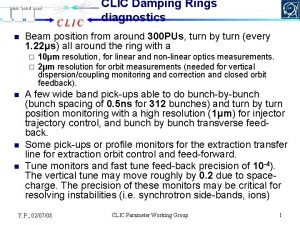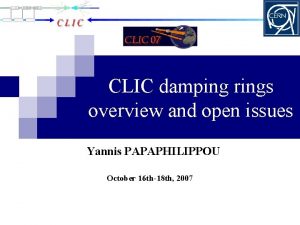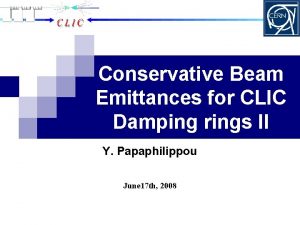Kicker Considerations for the CLIC Damping Rings M




![Double Kicker System[6 -8]: Basic Concept (Extraction) Extraction with one kicker magnet: Extraction with Double Kicker System[6 -8]: Basic Concept (Extraction) Extraction with one kicker magnet: Extraction with](https://slidetodoc.com/presentation_image_h/844e31a187fbb7c4bdb3960680ff523a/image-5.jpg)
![Double Kicker System for Extraction [8]: Implementation Ø 1 st kicker system (in damping Double Kicker System for Extraction [8]: Implementation Ø 1 st kicker system (in damping](https://slidetodoc.com/presentation_image_h/844e31a187fbb7c4bdb3960680ff523a/image-6.jpg)








![Or…. . an “n-Cell” Inductive Adder From +ve adder An Inductive Adder [12] may Or…. . an “n-Cell” Inductive Adder From +ve adder An Inductive Adder [12] may](https://slidetodoc.com/presentation_image_h/844e31a187fbb7c4bdb3960680ff523a/image-15.jpg)


![References [1]: G. Rumolo, J. B. Jeanneret, Y. Papaphilippou, D. Quatraro, “Collective Effects in References [1]: G. Rumolo, J. B. Jeanneret, Y. Papaphilippou, D. Quatraro, “Collective Effects in](https://slidetodoc.com/presentation_image_h/844e31a187fbb7c4bdb3960680ff523a/image-18.jpg)

- Slides: 19

Kicker Considerations for the CLIC Damping Rings M. J. Barnes CERN TE/ABT Acknowledgements: L. Ducimetière & J. Uythoven January 14, 2010 LER 2010 Workshop 1

Overview Ø Review requirements for CLIC pre-damping and damping rings & comparison of CLIC, ILC & DAΦNE requirements; Ø Briefly discuss concept of double kicker system to reduce required field stability with respect to a single kicker system; Ø Show that striplines are necessary to achieve low longitudinal beam-coupling impedance; Ø Ideas for achieving low droop of pulsed field; Ø Summary of main challenges of requirements for CLIC predamping and damping rings. January 14, 2010 LER 2010 Workshop 2

CLIC General Layout (Selected) Key: PDR Pre-Damping Ring; DR Damping Ring. January 14, 2010 LER 2010 Workshop • Damping rings reduce beam emittance. • Requirements for longitudinal and transverse broad band impedance (low frequency part of the total machine impedance) are a few Ω longitudinally and a few MΩ/m transversally [1]. 3

Selected CLIC, ILC & DAΦNE Parameters CLIC Pre. CLIC CTF 3 Tail-Clipper ILC [3, 4] DAΦNE [5] 2. 86 0. 2 5 0. 51 1. 5 1. 2 0. 7 5 ~55 20 40 24[4] (tapered) 54. 8 (tapered) Effective length (m) 2*1. 7 4*0. 295 20*0. 32=~6. 4 ~0. 9 Field rise time [definition ? ? ] (ns) 1160 1490 ≤ 5 3 ~5 Field fall time [definition ? ? ] (ns) 1160 1490 NA 3 ~5 Pulse flattop duration (ns) ~160 Up to 140 NA NA 5. 9 5. 3 Damping Ring [2] Beam energy (Ge. V) 2. 86 Total kick deflection angle (mrad) Aperture (mm) Input pulse duration (ns) Flat-top reproducibility 1 x 10 -4 NA 1 x 10 -3 ? ? ~3 x 10 -3 ~7 x 10 -4 1. 4 x 10 -3 1. 5 x 10 -4 NA 1 x 10 -4 ? ? ± 0. 1 (Inj. ) ± 0. 1 (Ext. ) ± 0. 1 (Inj. ) ± 0. 01(Ext. ) ± 18 ±? ? ± 3 (x=± 27 mm @y=0) ± 10 (y=± 10 mm @x=0 50 5 (3 M burst) 50 PFN voltage per Stripline (k. V) ~± 35 ~± 25 ± 5. 6 Pulse voltage per Stripline (k. V) ± 17. 4 ± 12. 6 ± 2. 65 ± 45 Stripline pulse current [50 Ω load] (A) ± 347 ± 252 ± 53 ± 100 ± 900 Transmission line kicker pulse current (A) 184 134 NA NA NA Flat-top stability [inc. droop], per Kicker SYSTEM (Inj. ) (Ext. ) Field homogeneity (%) Repetition rate (Hz) January 14, 2010 LER 2010 Workshop 4
![Double Kicker System6 8 Basic Concept Extraction Extraction with one kicker magnet Extraction with Double Kicker System[6 -8]: Basic Concept (Extraction) Extraction with one kicker magnet: Extraction with](https://slidetodoc.com/presentation_image_h/844e31a187fbb7c4bdb3960680ff523a/image-5.jpg)
Double Kicker System[6 -8]: Basic Concept (Extraction) Extraction with one kicker magnet: Extraction with two kicker magnets: Ø Requires a uniform and stable magnetic field pulse. Ø Two “identical” pulses are required; Ø One power supply sends pulse to 2 “identical” kickers. (Anti-Kicker) Ø 1 st kicker system for beam extraction; Ø 2 nd kicker system for compensation of jitter of deflection angle (ripple & droop) from 1 st kicker; Ø Figure shows 1 st and 2 nd kickers separated by a betatron phase of 2 nπ: for a betatron phase of (2 n− 1)π the 2 nd kick is in the other direction. January 14, 2010 LER 2010 Workshop (Kicker) 5
![Double Kicker System for Extraction 8 Implementation Ø 1 st kicker system in damping Double Kicker System for Extraction [8]: Implementation Ø 1 st kicker system (in damping](https://slidetodoc.com/presentation_image_h/844e31a187fbb7c4bdb3960680ff523a/image-6.jpg)
Double Kicker System for Extraction [8]: Implementation Ø 1 st kicker system (in damping ring) for beam extraction; Ø 2 nd kicker system (in extraction line), for jitter compensation, separated by a betatron phase of π from 1 st kicker. Ref [9] shows a factor of ~3. 3 reduction in kick jitter angle, w. r. t. a single kicker, with a double kicker system: the fact that the improvement was not even greater is attributed to errors in the optics and errors in estimating horizontal displacement (due to insufficient position resolution of the BPMs BUT Mark Palmer showed better than 10 µm resolution has now been achieved[13]). January 14, 2010 LER 2010 Workshop 6

Example of Double Kicker System for DR Extraction Discussed later… Ø 1 st kicker system (in damping ring) for beam extraction; Ø 2 nd kicker system (in extraction line) for jitter compensation. Assuming a 10 m separation between the 1 st and 2 nd kickers (i. e. time of flight ~33. 3 ns for beam and ~50 ns for kicker current pulse), the two kicker systems are in parallel. A series connection would require a ~16. 7 ns delay loop, for the beam, so that beam bunches and kicker field are synchronized in time at the 2 nd kicker system! – hence use electrically “parallel” kickers! KEK/ATF system used ferrite loaded kicker magnets to demonstrate the double kicker concept [9]. January 14, 2010 LER 2010 Workshop 7

Comparison of CLIC Requirements with Two Ferrite Loaded Kickers CLIC Damping Ring CLIC Pre. Damping Ring SPS Extraction (MKE 4) LHC Injection 0. 0143 5*0. 144 4*0. 325 T∙m Field rise-time 1490 1160 ~1100 900 ns Field flat top duration 160 10500 ≤ 7860 ns Field fall-time 1490 1160 ~1100 3000 ns ± 0. 015 (Ext. ) ± 0. 07 (Ext. ) ± 2 ± 0. 5 % 2@32 & 3@35 54 mm Transmission line kicker, total ∫B∙dl Flat-top stability (including ripple & droop) 20 / 36 55 / 71 (unshielded / shielded) Magnet Length 1. 7 2*1. 7 5*1. 7 4*2. 65 m System Impedance 50 50 10 5 Ω Magnet Current 134 / 241 184 / 238 2500 & 2560 5400 A PFN Voltage 13. 4 / 24. 1 18. 4 / 23. 8 50 & 51. 2 54 k. V Aperture (full) “height” • Specified rise/fall similar for all 4 systems considered here ; • Flat-top stability requirements significantly more stringent for CLIC than existing systems X; • PFN voltages less than for LHC injection LHC Injection Kicker Magnet . 8

Ferrite Loaded Kickers: Beam Coupling Impedance In order to reduce beam coupling impedance, in a transmission line kicker, the ferrite must be shielded from the beam by providing a path for beam image current. However the design must ensure that eddy-currents, induced by the fast rising field, do not unduly increase field rise-time. HV Plate Ferrite LHC Injection Kicker: ceramic tube with “beam -screen” conductors in slots MKE Kicker: serigraphy on ferrite January 14, 2010 (aperture: 38 mm 54 mm) LER 2010 Workshop 9

Striplines - 1 • CTF 3 Tail-Clipper, ILC & DAΦNE prototype damping ring kickers employ tapered striplines 295 mm • ATF (http: //www. cockcroft. ac. uk/papers/Cockcroft-07 -14. pdf): bunches must be extracted individually from the damping rings: because of the limited time available to damp the beam before extraction, injection must be on-axis, and with injection of the full charge in any RF bucket in one shot. Thus, kickers for injection and for extraction are required that have rise and fall times less than the 3 ns separation between two bunches. CTF 3 striplines (~1. 52 m) Taken from: D. Alseni, LNF-INFN, “Fast RF Kicker Design”, April 23 -25, 2008. Ceramic Support Elliptical cross-section (increases deflection efficiency). Feedthru Beam DAΦNE Stripline (~0. 94 m) January 14, 2010 Much research has been carried out, for ILC & DAΦNE, into tapered, elliptical cross-section, striplines and wide-band feedthrus [10]. By tapering the transition between the kicker structure and the adjacent beam pipe it is possible to reduce [10]: • the non uniformity of transverse deflection as a function of the transverse position; • the contribution of the kicker to the machine impedance; • the reflection coefficient at high frequency (short pulses for ILC). An elliptical cross section minimizes the variation of the vertical dimension of the beam pipe between the injection region and the adjacent dipole region and increases the deflection efficiency [10]. LER 2010 Workshop 10

Ferrite Loaded Longitudinal Beam Impedance Can probably be reduced by increasing length of taper: needs R&D. DaΦne Shielded MKI Reqd. Longitudinal Z for DR [1]. • Longitudinal beam coupling impedance of DAΦNE striplines is higher than that of a screened MKI kicker below 200 MHz; • Longitudinal beam coupling impedance of DAΦNE striplines is significantly less than that of a screened MKI kicker above 400 MHz; • Requirements for longitudinal broad band impedance (low frequency part of the total machine impedance) is a few Ω [1] – external circuit is also important to contribution [11]; • Bunch spacing in CLIC DR=0. 5 ns. BUT, 160 ns pulse per 1. 2μs ring length: expected frequency lines of DR & PDR are ~820 k. Hz spaced; • Also remember that screening/shielding requires ferrite aperture to be increased! Conclusion: striplines are required to achieve adequately low longitudinal beam coupling impedance. January 14, 2010 LER 2010 Workshop 11

Striplines - 2 • Tapering of ILC striplines reduces effective length, in comparison with central (untapered) section, to ~90% for DAΦNE; • When HV is applied, the possibility of discharges is higher in the end-sections of the kicker electrodes, where the stripline is closer to the vacuum tube [10]. NOTE: CLIC pulse is significantly longer than DAΦNE pulse; • HV 50 Ω (wide band) commercial feedthroughs do not exist and INFN has developed & tested one. Wide band feedthroughs are important to keep low beam impedance for the kicker even well beyond the DAΦNE Striplines [7]. frequencies content of the input pulse [10]. (54. 8 mm d at center; 78 mm d at ends) • KEK has also developed an HV coaxial connector, designed using HFSS, which provides much improved impedance matching in comparison with their original connectors [8]. January 14, 2010 LER 2010 Workshop 12

Contributors to instability/ripple & droop Feedthroughs Charging Power Supply PFL Switch Z=50Ω Schematic of one possible stripline kicker system Kicker System - Electrical • Charging power supply (not expected to be significant contributor for “slow” charging of PFL); • Pulse Forming Line (PFL) and transmission lines [attenuation]; • Switch (dynamic characteristic and temperature effects); • Feedthroughs; • Terminator (frequency dependence of value and temperature effects); • Impedance matching of system. Others • Long-term temperature effects (e. g. switches for LHC kicker dump generators 0. 2%/˚C ambient); • Differences between striplines of kicker & anti-kicker; • Imperfections in beam-line elements/alignment between kicker & anti-kicker. January 14, 2010 LER 2010 Workshop 13

Compensation of droop due to PFL Reels of PFL • One of several problems, for stability, is PFL droop. • PFL (cable) gives low ripple pulses, but low attenuation is essential (especially with longer pulses) to control droop and “cable tail”; • Frequency dependent attenuation, of transmission cable, might be usable to compensate for PFL droop, but increased cable tail is a potential problem. Theoretical simulations (“ideal” switch): “Cable Tail” is a potential problem. Note: ~500 ns rise-time Ø RG 220 U PFL (without compensation): droop over 160 ns ~0. 14%; Ø With 60 m transmission cable to ‘compensate’ for droop: ± 0. 01% over ~240 ns. But 0. 01% droop is significant c. f. required 1. 5 x 10− 4 stability for DR extraction!. (Note: ~500 ns rise time); Ø Anti-kicker will help reduce this effect. January 14, 2010 LER 2010 Workshop 14
![Or an nCell Inductive Adder From ve adder An Inductive Adder 12 may Or…. . an “n-Cell” Inductive Adder From +ve adder An Inductive Adder [12] may](https://slidetodoc.com/presentation_image_h/844e31a187fbb7c4bdb3960680ff523a/image-15.jpg)
Or…. . an “n-Cell” Inductive Adder From +ve adder An Inductive Adder [12] may be a promising means of compensating for losses in the PFL and transmission cables. The adder consists of: • A multi-cell primary circuit; • A single secondary winding; • A fast pulse transformer with adequate voltage isolation. Striplines Capacitor bank Trigger circuit Vpk≈n*Vchg Each primary circuit has a fast switch. The switches can be turned on and off independently, via trigger circuits, to provide some pulse shaping. Ø Many cells may be required to achieve fine control over pulse shape (to be studied further). Ø Good for machine protection & reliability (redundancy) too. n-Cell Inductive Adder: adapted from [12] January 14, 2010 LER 2010 Workshop 15

Switch • Thyratron or semiconductor switch (semiconductor switch preferred for repetition-rate, long-term reliability & low maintenance); • Se • For “non-inductive adder” semiconductor switch: MOSFETs (stacked in series) or a Fast Ionization Dynistor (FID) probably required (very high power IGBTs and IGCTs are relatively slow and may exhibit long switchon tail) – R&D required; • For an “inductive adder” semiconductor switch: MOSFETs or IGBTs – collaborate with ILC (also on design of pulse transformer); • Switch should not be too fast, so as to avoid exciting oscillations with parasitic inductance and capacitances (maybe add series inductance to slow-down current rise time) – R&D required; • Temperature rise of semiconductor switch, during current pulse, may be an issue, as this would effect the value of on-state resistance – R&D required. 16

Summary 1. 2. 3. 4. 5. 6. Beam coupling impedance issues will require the use of striplines, rather than a ferrite loaded kicker magnet; Short duration pulses (fast rise and fall) are advantageous for minimizing the total duration of the pulse. Hence a multi-cell inductive adder may be a good choice to: • Minimize dissipation in terminators (and therefore thermal effects); • Achieve reliable insulation, especially at ends of striplines, and adequately low beam coupling impedance of striplines – R&D required; Stability of DR extraction kicker (0. 015% reqd. ) will be a significant challenge especially because of relatively long (160 ns) pulse length. The following require R&D; • Power supply – probably OK for slow charging; • Choice between PFL & alternative (e. g. inductive adder); • Switch; • Transmission cable; • Feedthroughs; • Striplines; • Terminator. A double kicker system relaxes the requirements for individual kickers, but this has never been tried at CERN. KEK-ATF achieved a factor of 3. 3 reduction in kick jitter angle, w. r. t. a single kicker: the fact that the gain was not even greater is attributed to errors in the optics and errors in estimating horizontal displacement (due to insufficient position resolution of the BPMs: BUT Mark Palmer showed better than 10 µm resolution [13]) –– R&D required. Collaborate with ILC, e. g. on Inductive Adder. A Doctoral Student has accepted a post/project to study the PDR & DR kickers. January 14, 2010 LER 2010 Workshop 17
![References 1 G Rumolo J B Jeanneret Y Papaphilippou D Quatraro Collective Effects in References [1]: G. Rumolo, J. B. Jeanneret, Y. Papaphilippou, D. Quatraro, “Collective Effects in](https://slidetodoc.com/presentation_image_h/844e31a187fbb7c4bdb3960680ff523a/image-18.jpg)
References [1]: G. Rumolo, J. B. Jeanneret, Y. Papaphilippou, D. Quatraro, “Collective Effects in the CLIC Damping Rings”, EPAC 08, pp 658 -660. [2]: Y. Papaphilippou, “PARAMETER SPECIFICATION, EDMS#. . . Kickers for the CLIC Damping and Pre-damping Rings, PBS reference: ………. ” (Draft), 27/02/2009. [3]: http: //www. cockcroft. ac. uk/papers/Cockcroft-07 -14. pdf [4]: T. Naito et al, “Development of Strip-line Kicker System For ILC Damping Ring”, PAC 07, pp 2772 -2774. [5]: D. Alesini, S. Guiducci, F. Marcellini, P. Raimondi, “Fast Injection Kickers for Daphne Collider and ILC Damping Rings”, DAPHNE Technical Note, INFN - LNF, Accelerator Division. Note I-17, June 6, 2006. [6]: T. Imai et al, “Double Kicker system in ATF”, XX International Linac Conference, Monterey, California, LINAC 2000. [7]: H. Hayano, “Multi-Train Extraction by Double Kicker System”, nm. BPM at KEK 3/12/2003. [8]: T. Imai, “DR Extraction by Double Kicker”, ISG 6, 14/11/2000, KEK. [9]: T. Imai et al. , "Highly Stable Beam Extraction by Double Kicker System“, KEK Preprint 2002 -16, KEK Accession No. 200227016, May 2002. [10]: D. Alesini, "Fast RF Kicker Design", ICFA Mini-Workshop on Deflecting/Crabbing Cavity Applications in Accelerators, Shanghai, April 23 -25, 2008. [11]: M. J. Barnes, F. Caspers, T. Kroyer, E. Metral, F. Roncarolo, B. Salvant, “Measurement of longitudinal and transverse impedance of kicker magnets using the coaxial wire method”, to be publ. in proc. of 23 rd Particle Accelerator Conference (PAC’ 09), Vancouver, Canada, May 4 -8, 2009. [12]: C. Burkhart, “Inductive Adder Modulators for ILC DR Kickers”, Cornell ILC DR Workshop, September 26, 2006. [13]: M. Palmer, “CESRTA Program: Damping Ring Hardware and Diagnostics”, Low Emittance Rings Workshop (LER 2010), January 12– 15, 2010, CERN. January 14, 2010 LER 2010 Workshop 18

Bibliography • • • M. J. Barnes, G. D. Wait, “Design and Measurements of a Damping Ring Kicker for the ILC”, proc of 22 nd Particle Accelerator Conference (PAC'07), June 25 -29, 2007, pp 846 -848. A. Wolski & W. Decking, “Damping Ring Designs and Issues”, proc. of 20 th Particle Accelerator Conf. (PAC’ 03), Portland, Oregon, USA, May 12 -16, 2003, pp 652 -656. M. Palmer, “Fast Kicker R&D in the Americas Region”, ILC 2007. D. Alesini, S. Guiducci, F. Marcellini, P. Raimondi, “Design and Tests of New Fast Kickers for the Daphne Collider and the ILC Damping Rings”, proc of the 10 th European Particle Accelerator Conf. (EPAC'06), June 2630, 2006, pp 1502 -1504. A. Wolski, “Research and Development Issues for NLC Damping Rings 2004 -2005”, CBP Tech Note-321, June 2004. T. 0. Raubenheimer, L. Z. Rivkin, R. D. Ruth, “Damping Ring Designs for a Te. V Linear Collider”, SLAC-PUB 4808, Dec. 1988. A. Wolski, “Critical R&D Issues for the ILC Damping Rings and New Test Facilities”, Cockcroft-07 -14. C. Pappas, R. Cassel, “Damping Ring Kickers for the Next Linear Collider”, Proceedings of 18 th Particle Accelerator Conference, New York, 1999, pp 1500 -1502. A. Wolski, “Risks for Linear Collider Damping Rings”, ISG 11, KEK, December 17, 2003. T. Naito, “Fast kicker performance in ATF”, Low Emittance Rings Workshop (LER 2010), January 12– 15, 2010, CERN. January 14, 2010 LER 2010 Workshop 19
 Cern clic
Cern clic Rception
Rception Clic
Clic Double entry sales
Double entry sales Clicséqur mon dossier citoyen
Clicséqur mon dossier citoyen Ingreso al sistema web res. 1102-404 y res. 785
Ingreso al sistema web res. 1102-404 y res. 785 Imagenes de clic
Imagenes de clic Palabras que empiecen con la letra a
Palabras que empiecen con la letra a Alphabet protocananéen
Alphabet protocananéen Clic paris emeraude
Clic paris emeraude Clic
Clic Dead clic
Dead clic S4x clic
S4x clic Soplo mesosistolico aortico
Soplo mesosistolico aortico Comptine toc toc toc qui toque à la porte
Comptine toc toc toc qui toque à la porte Stretch reflex
Stretch reflex Damping torque definition
Damping torque definition Application of voltmeter
Application of voltmeter Logarithmic decrement formula
Logarithmic decrement formula Damping coefficient c
Damping coefficient c
